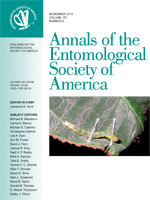The caddisfly, Ironoquia plattensis Alexander and Whiles, is a benthic macroinvertebrate endemic to the backwater sloughs and prairie wetlands in central Nebraska. These areas are subject to spring rains which wane to subsequent drying, and I. plattensis larvae are adapted to this hydric cycle, partitioning time as larvae in water and on land. Flooding, especially soil flooding, causes severe hypoxia, and most terrestrial organisms that are trapped underwater drown in a short period of time. Shallow, warm waters (>30°C) and aquatic environments that receive high nutrients can also experience severe hypoxia as a result of algal blooms, decomposition, and high biological oxygen demand. We exposed aquatic larvae, terrestrial larvae, and pupae of I. plattensis to severely hypoxic water and found that pupae were most sensitive, having a lethal time to 50% mortality (LT50) of 3.14 and 7.67 h, at 20 and 10°C, respectively. Aquatic fifth instars had an LT50 of 44.17 and 74.21 h and terrestrial larvae survived 61.68 and 89.89 h, at 20 and 10°C, respectively. The hypoxia tolerance of terrestrial larval stages suggests an adaptation to flooding while the sensitivity of the pupal stage suggests that fall flooding could cause significant mortality.
How to translate text using browser tools
1 November 2014
Hypoxia Tolerance of Larvae and Pupae of the Semi-Terrestrial Caddisfly (Trichoptera: Limnephilidae)
M. C. Cavallaro,
W. W. Hoback
ACCESS THE FULL ARTICLE
It is not available for individual sale.
This article is only available to subscribers.
It is not available for individual sale.
It is not available for individual sale.
backwater
conservation
Platte River
soil flooding
Trichoptera behavior





